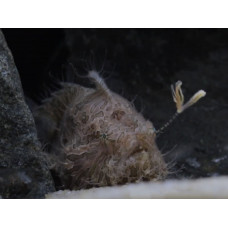Latin name
Antennarius striatus
Other names
Hairy frogfish
Identification
The body is short and spherical. The mouth is large with numerous tufted teeth on the jaws. The rough skin is covered with numerous closely spaced, branched, leathery projections. Belongs to the Antennarius striatus group, the closest species being Antennarius hispidus. Swim bladder present.
Features of fish fins
The dorsal fin has three separate barbs, followed by 11-12 soft rays. The first barb is directed forward and becomes a "fishing rod" called the illicium. At the end of the illicium is a worm-like esca, which is used to attract potential victims. The length of the illicium is equal to the length of the second barb. The second barb is mobile and almost vertical, and the third barb is posterior. At the end of the second and third barb rays are 2 to 7 worm-like projections. The anal fin has 8-10 (rarely 7) soft rays. The pectoral fins have 12-14 forked soft rays. The soft rays of the pelvic fins are also bifurcated.
Fish colouring
Uneven parallel dark stripes are clearly visible on the head, body and fins. On the sides of the body there are dark spots with lightly pigmented edges.
Distribution
Indo-Pacific: Red Sea, along the east coast of Africa to the Society Islands and Hawaii; north to Japan and south to Australia and New Zealand, including the coastal waters of Indonesia, the Philippines, Malaysia.
Habitat
Benthic species. Live in marine or brackish waters. Widely distributed in tropical and subtropical waters of all oceans, at depths from 10 to 219 meters. Live on rocky and coral reefs, rocks, sand or gravel. Found in weedy estuaries along the east coast of South Africa.
Size
Maximum body length 25 cm, usually up to 10 cm. Maximum published weight: 32.90 g.
Behavior
The males are very bloated, like a fugu.
Food and feeding habits
They are omnivorous, ambush of their victims.
Reproduction
Egg-laying. Males have richer coloration and elongated skin appendages than females. Eggs are enclosed in a ribbon-like sheath or mass of gelatinous mucus.
Fishing
It is considered a commercial fish and is particularly valuable for its flavor and nutritional qualities.
Relationship with a person
These fish are not dangerous to humans.
| Classification | |
| Phylum | Chordata |
| Class | Actinopterygii |
| Squad | Lophiiformes |
| Family | Antennariidae |
| Genus | Antennarius |
| Species | A. striatus |
| Features | |
| Conservation status | Least Concern |
| Habitat | Bottom |
| Life span, years | No information |
| Maximum body weight, kg | 0,0329 |
| Maximum length, cm | 25 |
| Sailing speed, m/s | No information |
| Threat to people | Edible |
| Way of eating | Predator |
Striated frogfish
Tags: striated frogfish



